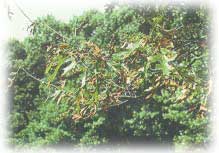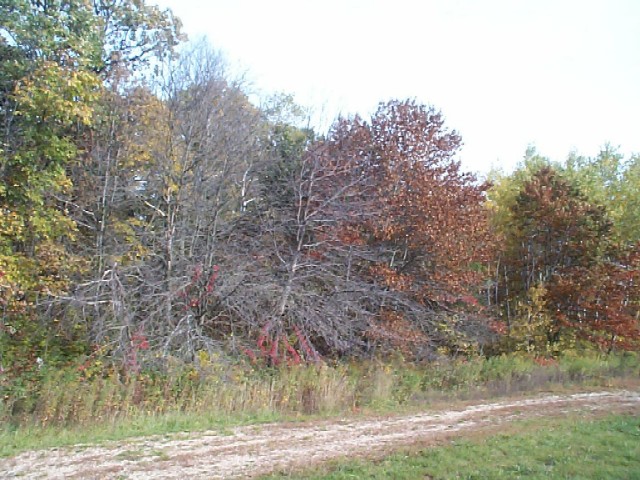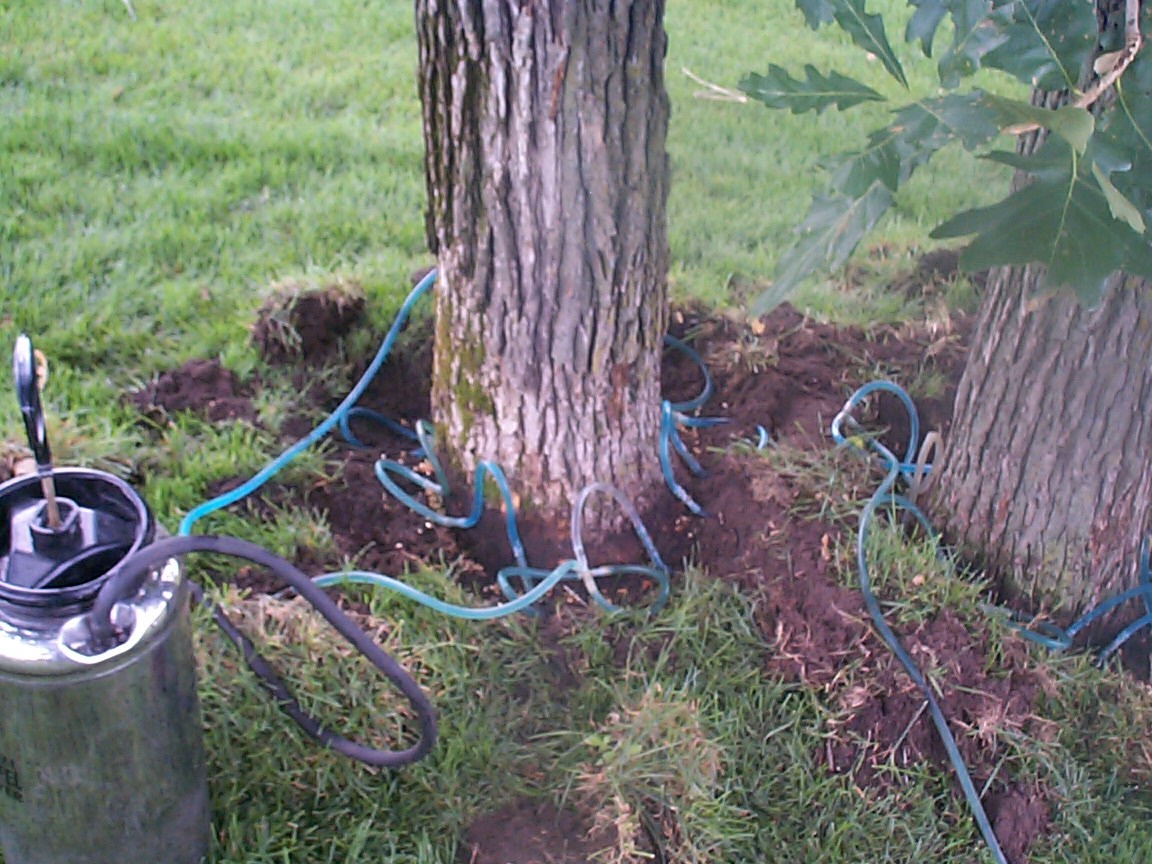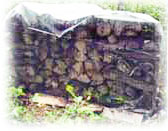Oak Wilt
Oak Wilt Program
In 1988, cities in Anoka County began discussing the control of Oak Wilt. In 1992, the City adopted a Shade Tree Ordinance and Oak Wilt Control Plan, with funding from the Department of Natural Resources.
The City would like to remind residents of the “no-cut” period for oak trees which starts April 1st and is effective through July 15th (Article 11.1400.4 of the City Code). This is to help prevent the spread of oak wilt. If you need to cut an oak tree or trees during the "no-cut" period, you must get a permit from the City prior to cutting.
For more information on this program, please contact John Witkowski, 763-235-1662 or jwitkowski@hamlakemn.gov
What are the causes of oak wilt?
 The lethal fungus Ceratocystis fagacearum causes oak wilt. The fungus invades water-conducting vessels and induces the formation of balloon-like projections called tyloses, which plug the vessels. As water movement within the tree slows, the leaves wilt and drop off the tree. Different species of oaks vary in susceptibility to the disease. Oak wilt is most often spread via root grafts between interconnected and grafted root systems.
The lethal fungus Ceratocystis fagacearum causes oak wilt. The fungus invades water-conducting vessels and induces the formation of balloon-like projections called tyloses, which plug the vessels. As water movement within the tree slows, the leaves wilt and drop off the tree. Different species of oaks vary in susceptibility to the disease. Oak wilt is most often spread via root grafts between interconnected and grafted root systems.Which trees are susceptible?
What are the symptoms of oak wilt?
- Red Oak Group - Trees in the red oak group usually drop their leaves within a three-week period either in late June or throughout July and August. Some lose a portion of their leaves in September, then rapidly lose all their leaves just after they bud in the spring.
- White Oak Group - Trees in the white oak group drop their leaves from either one or several branches for several years in a row. These trees do not always die and have a greater chance of surviving infection than red oaks.
How does the disease spread?
 Underground - Most oak wilt moves from diseased trees to healthy trees through interconnected roots (root grafts). Root grafts normally form between oaks of the same species; grafts between red and white oaks are rare. It is more likely that root grafts will form between red oaks than white oaks.
Underground - Most oak wilt moves from diseased trees to healthy trees through interconnected roots (root grafts). Root grafts normally form between oaks of the same species; grafts between red and white oaks are rare. It is more likely that root grafts will form between red oaks than white oaks.- Overland - Some oak wilt moves overland via sap-feeding beetles. In the spring, fungal mats (small masses of Ceratocystis fagacearum) develop under the bark of some trees that died from oak wilt the year before. These mats force the bark to crack open. The fungus produces a sweet odor that attracts sap-feeding beetles, which then pick up fungal spores while feeding on the mats. The beetles then fly to healthy oaks to feed on sap flowing from fresh wounds, thus infecting healthy trees. Overland spread can also occur when firewood or logs from infected trees harboring fungal mats are moved.
How do you confirm your tree has oak wilt?
- Collect living plants that exhibit varying stages of decline. Do NOT submit dead plants. For tree wilts, collect branches with a 1/2-inch to 1-inch diameter. Collect sample from branches, which are actively wilting, but not totally dead. Wrap in plastic to retain moisture. Keep cool until submitted.
- Submit a completed Sample Submission Form with each sample. Please include a phone number and/or email address.
- Ship samples immediately after collection.
- Ship samples by overnight delivery or mail early in the week to ensure fast delivery. Plant samples often decompose if left in the post office over the weekend.
- Please submit payment with each sample. Make checks payable to the University of Minnesota. (Please check our current prices.)
- Contact the Plant Disease Clinic directly with any questions at pdc@umn.edu or 612-625-1275
How do you prevent and manage oak wilt?
 Wounding, timing, susceptibility
Wounding, timing, susceptibility
Oak trees are most susceptible to overland spread in the springtime, from bud swelling until two to three weeks past full leaf development.
April 1-July 15. During this highly susceptible period, do not prune, cut or injure oaks! If an oak is wounded during this time, cover the wound immediately with tree wound paint. Tree wound paint does not help the wound closure process but does act as a barrier to the fungus. Limit the use of wound paint ONLY to the time period described above.
Overland infection can occur after July 15, so to take a cautious approach, do not prune or wound oaks from April 1-October 31.
Management through disruption of common root systems
Spread of oak wilt through grafted root systems is the most common way oak trees become infected. If healthy oaks of the same species are near an infected tree, removing the infected tree will not control the spread. In fact, the movement of the fungus through the root grafts may hasten after the prompt removal of infected trees. The best control measure is to install root graft barriers, which disrupt the common root systems between healthy and diseased trees. The most successful methods to install root graft barriers involve physically severing roots with a vibratory or cable plow or trencher. Barriers must be created in the correct location for success. Often, adjacent oaks that appear healthy may already be infected but have yet to show symptoms. A forest pest specialist, forester, or consultant trained in oak wilt management should work with you to find a barrier location.
Management through use of injected fungicides
Fungicide applications--macro infusions of Alamo™ fungicide into the tree trunk have been shown to offer up to three years of protection against oak wilt in red oaks and can be used therapeutically in the white oak group.
What do you do with diseased wood?
After installing root graft barriers, diseased wood may be removed and used for firewood or other wood products. Trees that have died from oak wilt can harbor fungal mats, so if this wood is moved, the fungal mats are moved as well, and the disease may spread to areas currently unaffected. Any trees that have died from oak wilt and that have bark tightly attached to the wood could harbor fungal mats. This wood must receive special treatment. Once that bark is loose and falls off the wood, the mats are no longer viable, and no special treatment is necessary; the movement of the wood is no longer a concern.
 Firewood
Firewood
Two methods of wood treatment are effective in preventing overland spread via firewood:
- Debarking (removing bark from the wood) the wood will prevent the fungus mats from forming. Debarking must be conducted before fungal mats form; thus, it should occur in the late summer, fall, or winter following tree death. Pile of wood covered by a tarp to prevent the spread of oak wilt.
- Cutting, splitting, stacking, and covering wood with a 4 ml (or thicker) plastic will also prevent overland spread. All sharp edges or stubs should be cut to eliminate the possibility of puncturing the plastic. The entire pile must be sealed all around. Seal the bottom by covering it with dirt and logs, or other heavy objects. If the wood is not burned over the winter following tree death, leave the tarp on through the next growing season (October 1) or until the bark is loose.
For more information click here.
Other wood products
Wood from infected trees may be sold to a sawmill or chipping facility - preferably one which is several miles away from the nearest red oak. Advise the purchaser that the infected trees with tightly attached bark must be utilized over the coming winter.
The oak wilt fungal mat does not survive well when it is dried out, exposed to other adverse conditions, or put in competition with other wood decay fungi. Thus, wood chips from infected trees are highly unlikely to serve as a source of disease inoculum or spores and can be used for landscaping.
Disinfecting your saw
Pruning saws, shears, and other pruning tools can spread disease organisms from one plant to another or from one part of a plant to another part of the same plant if not properly disinfected. While it may not be completely necessary to disinfect pruning tools each time you use them, making a habit of doing so can help reduce the chances of disease transmission among healthy plants and is especially important when working with plants that are considered irreplaceable.
To disinfect a tool or saw, remove all dirt and debris, (Take apart chain saws to soak the chain and bar.), soak in a solution of 70% isopropyl alcohol (rubbing alcohol) or a solution of 10% bleach for at least 5 minutes, rinse with clean water and air dry.
Sterilizing your tools is no guarantee against plant disease, but it can have a significant impact on disease incidence and severity.
What will occur if you do not attempt to stop oak wilt
If you allow the disease to progress, it will spread to healthy oaks that are grafted through roots to the diseased trees. In stands where oak is common and root grafting prevalent, an ever-widening pocket of dead oaks will form. In forests where oak is mixed with other species and is a minor component, the spread will be slower and may actually stop from a lack of root grafting. New pockets may also form via overland spread by sap-feeding beetles (see description of "over land spread").
Dead oak trees can serve as excellent den trees for wildlife. Oaks do not decay as quickly as aspen, birch and red maple, thus will provide shelter for wildlife for many years. Also, as oaks die, the site often becomes brushy for about ten years. The brushy area will attract warblers, grosbeaks, cuckoos, cardinals, grouse, rabbits, deer and shrews. Brown creepers may nest under the sloughing bark on dead trees. Dead trees will also furnish insects for birds, and larger specimens may provide perches for raptors.
